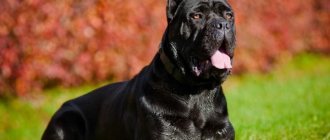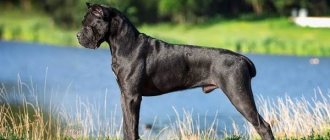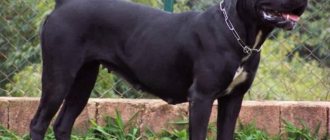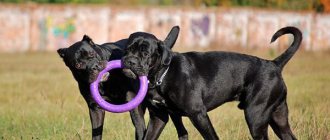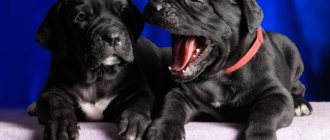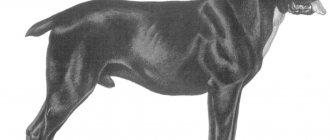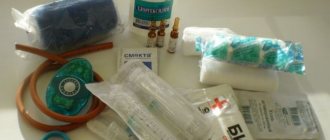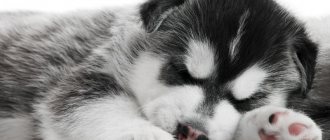Photo: dogfact.ru Cane Corso is a dog for gladiator fights and one of the most ancient breeds in the world. Strong and resilient protectors, reliable working dogs and faithful guards - all these are Cane Corsos. In our latitudes, this amazing breed is not yet so well known, but is gradually becoming more and more popular. So let’s talk about its features and specifics of care!
Story
The appearance of the breed occurs in Medieval Italy. These fearless dogs hunted wild animals, herded livestock, and were devoted guards.
But at the beginning of the 20th century, the number of these animals turned out to be minimal due to the aristocrats stopping keeping massive pets at court. Gradually, the individuals lost their purebredness - mixing of blood occurred.
In the second half of the 20th century, the history of origin took a new turn - breeders began to revive the breed and their efforts were crowned with success. In 1994, the pets received official recognition from the Italians, and then on the international stage. This allowed the roots of the corsa to be preserved.
Interesting Facts
The Cane Corso dog breed has been popular among owners for a long time. The history of its origin dates back to the times of Ancient Rome, so there are many interesting facts about this breed:
- It is considered one of the most valuable dogs in historical terms. Thanks to archaeological excavations, it was possible to discover the unique remains of ancient dogs of Italian origin, which are similar to the current Cane Corso.
- There is a mention of Cane Corso by the Italian poet Teofilo Folengo (1491-1544). There the author describes a mortal fight between a dog, a bear and a lion. Also, thanks to its fearlessness, this breed is mentioned in many famous works.
- The history of the origin of the name of the Cane Corso breed has not yet been precisely established. There are theories, but none of them have been officially confirmed.
- This breed of dog is widely in demand in Europe, where it is used by influential people as bodyguards.
- The Cane Corso can often be seen as a security guard at an expensive store in Europe; this adds prestige to the boutique itself and its owner.
- Politicians, famous businessmen and other influential figures are often seen accompanied by this breed.
- A representative of the breed named Boris received recognition from the FCI (International Association of Cynological Federations).
- The phrase: “brave as a Corso” can often be heard in Italy.
Description
During selection, breeders used purebred individuals. These dogs are muscular, confident dogs. They have an attentive gaze, interesting facial expressions, and strong bones, which makes the pet look angry and aggressive.
The animal has an athletic build:
- straight strong back;
- powerful legs, shoulders;
- the docked tail is compacted at the base;
- massive head, upturned muzzle, uniform and elastic skull;
- the forehead in front is slightly convex, and the occipital part is flattened;
- the nose is black, the nostrils are large;
- moderately sagging lips, tightly closing jaws;
- large teeth;
- the iris has a black tint (occasionally there are specimens with blue eyes);
- hanging ears of a triangular shape (they can be cropped);
- dense skin, hard shiny coat.
From the description of the breed it is clear that this is an elegant dog with powerful muscles. Fans of the animal especially highlight its endurance, tireless efficiency, and protective qualities.
Breed standard
The Italian Cane Corso is a dog of impressive size and strong build. At the same time, her exterior looks elegant - long strong legs, protruding muscles.
In 1999, the standards that an ideal representative of the breed must meet were first approved. They were slightly updated in 2015. Modern description of Cane Corso standards:
- Large head. The upper lines running along the skull and muzzle do not have pronounced folds and converge with each other.
- The skull is wide, the width and length of the cheekbones are equal. The forehead is flat in front, more convex towards the back of the head.
- The nose is large and black, with wide nostrils. If there is a gray “mask” on the muzzle, then the lobe may match its tone.
- The shape of the muzzle is square, proportionally 1/2 of the skull. The lips droop slightly on both sides. The jaws are powerful, the bite is desirable not straight, but undershot by 0.5 cm.
- The eyes are slightly convex and are of medium size. Widely located. Eye color is usually very dark. The look is lively and concentrated.
- The ears are triangle shaped and set wide apart. Not subject to mandatory purchase.
- The neck is equal in length to the head. Pronounced muscles.
- Straight back, short loin, wide croup.
- The tail is set high and quite thick at the base. Never curls or straightens vertically. No need to buy.
- The paws are strong, strong and flexible, very sinewy. The gait is most often a sweeping trot.
- The coat is short, glossy, and has slight undercoat.
- Color options - black, wheaten, fawn, gray, brindle.
- The weight of a Cane Corso dog ranges from 40 to 50 kg, height from 60 to 68 cm (females are lighter and smaller than males).
For show dogs there is a list of defects, both external and behavioral. This is, for example, causeless aggression or a curling tail.
Varieties
The descendants of the Corso Como have a peculiarity - a varied appearance. The animals contain features of a Great Dane, Mastiff, Bullmastiff, and Boxer.
Carso types:
- Likeness of a Great Dane: Tall, slender, narrow-chested, calm, moderately touchy and devoted to his owner.
- Resembling a Bullmastiff: Active, stubborn, with a muscular chest and back.
- Almost Mastiff: Phlegmatic, lazy dog, but is a good guard and can easily tolerate heat.
- Boxer type: The body has a square shape. An energetic, cheerful pet.
- Similar to the Staffordshire Terrier: Muscular back, limbs, chest. The animal is strong and resilient. But these dogs behave aggressively towards other brothers.
How to choose a pet
Beginning dog breeders are usually recommended to choose an Italian Mastiff puppy no older than 3 months, since at an older age he allegedly refuses to recognize a new owner. However, many Cane Corso owners disagree with this.
From their own experience, they know that at 5 months and a little later, the pet gets along well with all family members in the new home if they manage to immediately establish contact with it.
Then he chooses the owner himself. Therefore, when purchasing, it is more important to pay attention to other points (especially if in the future you plan to exhibit the dog or use it for mating):
- Compliance with appearance standards. Reasons for culling a Cane Corso (in addition to those noted) are white, cream, chocolate colors, tan marks on any background, light irises and strabismus, depigmentation of the nose and eyelids, a very short tail or its absence, elongated and soft fur. .
- Availability of documents with pedigree, passport with vaccinations. At the same time, it would be good to take a look at the Cane Corso’s parents, find out about their health, and what they are fed. Information about the fate of the offspring is very important. For example, you should avoid buying puppies from a line that already had pups with dysplasia or allergies.
- The baby's health status. This is a traditional examination of the coat and skin, mucous membranes, and pads on the paws for the presence of injuries, diseases, and parasites.
- Puppy behavior. A healthy Cane Corso is characterized by curiosity, activity, courage, and goodwill. If he shows cowardice or aggression, it is better to refuse the purchase. Moreover, an Italian mastiff with such behavior is subject to disqualification according to the standard.
Before buying a Cane Corso, it is advisable to talk with a specialist in this matter. And under no circumstances should you purchase a dog secondhand or from a dubious kennel.
Characteristics
Corso representatives are large in size. An adult dog has the following parameters:
| Male | Bitch | |
| Height at withers/cm. | 62-70 | 58-66 |
| Weight, kg. | 45-50 | 40-45 |
You can understand your pet’s compliance with breed standards by the development indicator by month:
| Age/month | Bitches | Males | ||
| Height/cm | Weight/kg | Height/cm | Weight, kg | |
| 3 | 42 | 12,5 | 49 | 13,5 |
| 4 | 47 | 16,5 | 56 | 18 |
| 5 | 55 | 22,5 | 62 | 24,5 |
| 6 | 57 | 28 | 64 | 31,5 |
| 7 | 58 | 33,5 | 65 | 37,5 |
| 8 | 59 | 36 | 65,5 | 40 |
| 9 | 59,5 | 38 | 66 | 42 |
| 10 | 60 | 40 | 66 | 44 |
| 11 | 61 | 41,5 | 67 | 45,5 |
| 12 | 63 | 43 | 67 | 47,5 |
| 24 | 64 | 45 | 68 | 50 |
This is an average characteristic to guide the owner while the dog is growing. These weight and height tables allow you to track the development of your pet at any age.
Character and appearance
Individuals of the Cane Corse breed are calm, loyal, and intuitive. Instincts allow the pet to quickly make a decision - if necessary, to defend the owner in case of danger. As long as he lives in a family, he protects the peace of the owners.
Sometimes these animals are stubborn, but their predisposition to dominate over the owner is less pronounced.
The purebred Corso is characterized by the following traits:
- Loyalty – it is difficult to feel separation from the owner.
- Kindness – treats children with care.
- Accommodation with pets in the family.
- Love of active games outside, running, long walks.
- Barks only when there is danger.
- Does not show unmotivated aggression.
- Able to control power.
Canicors is an excellent guard. It is not for nothing that this breed is also called the Italian watchdog. If the guest is friendly with the owners, the pet will remain calm, but ready to attack. In an unfriendly relationship, the dog immediately shows that he is in control, but will take active action only after the owner’s command or when aggression occurs.
The innate instinct to protect the weak contributes to the fact that the pet takes care of children with special zeal.
Although the pet has a formidable appearance, purebred dogs are not able to live without an emotional connection. They strive to gain the owner's approval, and changing ownership is considered a serious challenge.
According to the standard, the color of the breed should be the following colors:
- grey;
- chocolate;
- black;
- brown;
- brindle;
- ginger;
- pale yellow.
Rare ones include:
- murugi color - a variety of dark brown, the tips are black;
- Formentino color is red, endowed with a gray or blue mask.
The presence of white spots on the fingertips, chest, and nose is allowed. There are known types of tan with a black-tiger coat color.
Brief history of origin
Italy is officially considered the birthplace of this dog. The distant ancestors of the Cane Corso - Molossian dogs - lived in Ancient Rome. They had many functions: guard (protection of the owner’s property and himself) and military service, participation in gladiatorial battles and hunting, even monitoring children. Therefore, their main qualities were large size, fearlessness, and devotion to man.
Over the thousand years of its existence, the breed has undergone some changes, and yet the appearance of the dog has changed slightly. The number of Cane Corsos decreased by almost half during the First World War. The breed was on the verge of extinction during World War II - these dogs were poorly fed due to lack of food.
Despite all the difficulties, today the Cane Corso is one of the most beautiful and popular breeds not only in Italy, but throughout the world. Much credit goes to Giovanni Nizzo for this. This Italian, together with like-minded people, gathered representatives of the breed from all over the country in the early 80s of the last century and created a nursery.
For the first time, Cane Corso breeding began there on a professional level.
Already in the 90s, the FCI established standards that today are met by more than 3,000 representatives of the Italian Mastiff (the second name of the breed) around the world. Changes were made to them in 2016. In the new version, the approach to docking the Cane Corso's ears and tail has changed.
Education and training
When training a Cane Corso puppy, it is important to teach the pet to recognize the owner as the leader - then he will obey unquestioningly. Classes with animals are based on games, without rudeness or punishment, but it is important for the owner to be persistent.
The puppy should undergo a general training course, and after 9 months, learn the “City Dog” program for socialization. Classes should be entrusted to an instructor who has positive recommendations. If you make every effort during training, your pet will grow up obedient.
When raising an animal, it is important to follow the advice of experienced owners and start training from the first day the pet appears in the house.
First, the puppy is toilet trained, then to the main commands, trained before feeding, praised, and given a treat.
Where to buy and price
Not all kennels in Russia offer Corsi puppies. The minimum price is 50,000 rubles, but puppies with documents and eminent parents cost an order of magnitude more. Finding a nursery is possible. It is better to wait for a puppy, being sure of its breed, than to buy it on hand in an unknown place. There is a regular selection of Cane Corso babies in the nurseries ARNAS FIORISTA, Ollada Harlequin, and Dynasty Champions.
Cane Corso has an interesting history; they are one of the oldest breeds of large Molossians, common in ancient Rome. Phlegmatic pets will become real defenders of the owner, his entire family, for children - friends, nannies. The advantages of the breed far outweigh the disadvantages.
Care and maintenance
The dog feels good at home, in an enclosure. But since she is a freedom-loving person, it is unacceptable to put her on a chain. The best option for the animal would be to live outside the city, in a fenced area. In winter, you cannot keep your pet outside, since the fine undercoat does not protect against frost.
Care and maintenance in the apartment:
- Massage, use of shampoos, and regular brushing will help preserve the beauty of the coat. For these purposes, medium-hard brushes are used. After cleaning the pet, comb it with a fine-toothed comb according to the hair growth.
- Wax and dirt are regularly removed from the ears using a cotton-gauze swab.
- Discharge from the eyes is carefully wiped with a clean cloth moistened with a solution of chamomile flowers or boiled water.
- Tartar is removed in a veterinary clinic.
- Bathe the animal using zoo shampoo.
- Regularly inspect the paw pads for wounds. Claws are trimmed in a timely manner.
- The apartment will provide your pet with a spacious place (bed, changeable sheets).
- Walk with the animal 2-3 times a day for 1-2 hours.
- They buy special bones for the dog for brushing teeth and playing.
The first mating should be done when the dog reaches the age of 2 years. Early birth will negatively affect the health of the bitch.
Conditions of detention
Despite the fact that the dog of this breed is of considerable size, it does not require much space to keep a Cane Corso.
Ideally, the dog should live in a private house in the yard, but in an apartment you can create comfortable conditions for the animal. To do this, you will have to walk the dog more often.
On your backyard Corso you will need a cozy kennel. It must first be insulated so that the “Italian” feels good in the cold. But even at -20 degrees the dog can be walked.
You shouldn’t put a pet of this breed on a chain; he loves freedom too much and needs constant contact with people.
Nutrition
In order for your pet to feel physically good, it is necessary to follow a nutritious diet. The amount of food intake, as well as the portion of food, depends on the age of the pet. Owners choose the following types of dog food:
- Dry. A product that is safe for health is expensive, but the owner is freed from regularly preparing a menu for the animal. The finished product contains vitamins, nutrients, and microelements. An experienced veterinarian will help you choose the right dryer. If required, the doctor will recommend additional medications.
- Natural. This is an inexpensive option compared to dry food. The main advantage of healthy food is that the owner knows what the dog is eating. Optimal nutrition: cereals, vegetables, meat (low-fat varieties are used), milk, fish.
During pregnancy, the bitch's diet is changed 14 days before giving birth. It is allowed to purchase vitamins or special food. For the first 7 weeks, the dog eats according to its usual diet, and then the daily portions are gradually increased (attention is paid to cereal products).
What to feed your Cane Corso
It is best to feed your Cane Corso a balanced diet for large breeds. The diet must contain vitamins, fish oil, protein and collagen. It is important to periodically change the diet, depending on the age, load and health of the animal.
A puppy up to 4 months old is fed five times a day, and in strict doses, because they cannot overeat. You need raw beef, boiled poultry, rabbit and some porridge, oatmeal, carrots and sour milk. Dairy products and cottage cheese are given in doses, because an excess of calcium is fraught with joint problems.
Photo: placepic.ru
For puppies up to one year old, it is time to introduce beef bones into their diet and increase the amount of calcium. Gradually he is transferred to three meals a day and the caloric content of food is increased in proportion to the load. You should not give your Cane Corso food too fatty - this will almost guarantee problems with the liver and pancreas.
After a year, dogs seem to be able to eat forever because their muscle mass increases. Offal and offal are suitable - they are rich in essential microelements and collagen. Sometimes you can give seasonal vegetables, fruits, berries and even nuts. Adult Kane Koso eat twice a day, and the basis of the diet is raw or boiled meat, boiled vegetables and cereals.
Photo: youtube.com
Health and treatment
The breed's problems include a predisposition to specific diseases, so you need to carefully monitor your pet's health. Dangerous pet pathologies are considered:
- dysplasia;
- plague;
- epilepsy;
- entropion;
- hemophilia;
- allergy;
- rabies;
- thyroid diseases;
- umbilical hernia;
- bloating.
The health of the Cane Corso is influenced by heredity, as well as the care of the owners. Vaccination administered up to a year will help strengthen immunity. Further vaccinations are given every 12 months throughout the animal's life.
The pet must be regularly examined by an experienced doctor - during the medical examination, the doctor will explain how you can notice signs of disease, provide assistance if the condition worsens, and improve the functioning of internal organs.
Diseases and life expectancy
Life expectancy largely depends on maintaining good health. On average, Cane Corsos live 13-14 years. The most common are diseases of the hip and elbow joints. The main reason for this is the heavy weight, which exerts serious pressure.
Cane Corsos are susceptible to injuries to joints and bones, leading to serious consequences, including death. Running and other active training should be carried out at an acceptable pace; if the owner cannot monitor the quality of the training himself, it is better to contact a dog handler. Diseases of the eyes, thyroid gland, nervous system, and allergic reactions are less common. It is recommended to be examined by a veterinarian annually to detect them in a timely manner.
Advantages and disadvantages
If you look at the positive and negative aspects of the Cane Corso Italiano, then a lot depends on the methods of raising the pet, its character, and lifestyle.
| Advantages | Flaws |
| Ease of training | Requires a lot of space |
| Loyalty to the owner | Need active, active games |
| Safety for children | Out of boredom, your pet chews furniture or shoes |
| Ability to control powers | The dog is not suitable for sedentary people |
| Guard qualities without special lessons | Corso does not like to be alone and eats a lot |
| Obedience | Small animals are considered prey for the canoe (unless they live together) |
An affectionate, kind dog, he is attentive to his owner and demands the same attitude towards himself.
What qualities will dominate in a pet depends on the owner, because it is he who chooses the training method.
Character of the Cane Corso
Despite their frightening appearance, Italian giants are completely non-aggressive, but they really do not like strangers. The opinion that such a massive dog is lazy and apathetic is also fundamentally wrong - they are fast and energetic.
Traits and Temperament
Cane Corso easily fit into the family and become its full-fledged member. Well-mannered dogs are very balanced and show aggression only to protect loved ones or territory. A huge dog allows its loving owners almost anything.
Photo: mypets24.com
Attitude towards the owner
Cane Corso needs a strong and strong-willed owner. Otherwise, a pet with character will never recognize the leader and will not obey well. Please note that dogs do not tolerate rude and disrespectful treatment.
Photo: 74.ru
Attitude towards children
Surprisingly, wayward Cane Corsos turn into caring and endlessly patient nannies. Due to the fact that the dog is massive, a child is unlikely to be able to seriously harm it. And she, in turn, will protect the baby and will not allow herself a single careless movement.
Photo: pinterest.ru
Relationships with other animals
In order for Cane Corsos to get along well with other dogs, they need to be socialized and trained from the first months. An adult dog will not tolerate competition and will be irritated. But they get along with small animals much more willingly and do not offend the weak.
Photo: vasiabelka.ru
List of suitable nicknames
When coming up with a name for a pet, it is important that it is short (easily pronounced by the owner). Popular for Cane Corso are:
| Boy | Girl |
| Archie | Aina |
| Argon | Molly |
| Bonya | Betty |
| Vinci | Sally |
| Hector | Nancy |
| Django | Ghersi |
| Prince | Irma |
| Tyson | Alice |
| Osman | Barça |
| Theo | Stacy |
| Norman | Sheldy |
| Khaki | Chloe |
In order for an animal to remember its name, it must be mentioned in positive cases, and avoided when punished.
Cane Corso - photo
The Cane Corso breed is so powerful and spectacular that it is impossible to remain indifferent. So we couldn’t while we were preparing this selection of photos for you!
Photo: id.pinterest.com
Photo: corso-club.com Photo: klkfavorit.ru Photo: 74.ru
Photo: pinterest.ru
Photo: lapkins.ru
Photo: barbos.club
Photo: glorypets.ru
Photo: regionoperator.ru
Photo: krasivosti.pro
Photo: krasivosti.pro
Photo: for-pet.ru
Photo: star-karuna.ucoz.ru Photo: sobakevi4.ru
Photo: cat4you.ru Photo: krasivosti.pro
Photo: klkfavorit.ru
Photo: kotsobaka.com
Photo: zen.yandex.ru
Photo: foxfan.ru
Photo: porodisobak.ru
Photo: autogear.ru Photo: olladaarlekin.com
Photo: youtube.com
Did you like the post? Subscribe to our channel in Yandex.Zen, it really helps us in our development!
Rules for choosing puppies
It is difficult to purchase a purebred Cane Corse. You should enlist the help of an experienced dog handler.
When contacting breeders, you should pay attention to such nuances as:
- Availability of official documents with the results of checks for the absence of ongoing dysplasia in the baby’s parents.
- Was testing carried out to identify the dog’s unbalanced mental state, with a corresponding note in the certificate?
- Do the parents have a breeding assessment of the exhibition not lower than “very good”.
Puppies must be branded, ears and tail docked, and vaccinated. Healthy babies grow up calm, have an appetite, a strong psyche, and courage.
It is better to buy a pet after 5 months, when the teeth have changed, the bite has become clear, and the eye color has normalized.
Requirements for maintenance and nutrition
All dogs, regardless of breed, need special proper nutrition, and the Cane Corso is no exception. The health of the pet and its life expectancy depend on feeding. The issue of nutrition must be approached responsibly by every owner. Therefore, it is recommended to carefully read the information on what and how to feed your Cane Corso.
What to feed
Initially, you need to decide on the type of feeding; it can be feed or natural food.
Feeding Features:
- Dry food should be premium, it is not cheap, but it has its advantages. The owner does not have to bother with preparing food for the pet; it is enough to provide the dog with food on time and in the right quantity. The “drying” contains vitamins and nutrients that your pet needs. In order to choose the right food, you should contact a veterinarian who will select the food.
- Natural food is cheaper, but cooking takes time. The dog cannot be fed “from the table”; it needs a separate kitchen. In addition, the animal may need special vitamins.
During pregnancy, a dog's diet changes in the last weeks. The bitch needs special vitamins; to simplify the task, you can switch to dry food for pregnant women.
Forbidden food:
- tubular bones;
- pork and other fatty meats;
- lard of any origin;
- bird skin (in any form);
- smoked products;
- pickles;
- sweets and foods high in carbohydrates;
- flour products;
- fish with bones, river.
Puppy food
Recommendations for feeding a Cane Corso puppy:
- From 3 weeks to 4 months, feeding should be done 4 times a day.
- From 4 to 7 months – 3 times a day.
- From 7 months the puppy is switched to two meals a day.
- The diet must contain the necessary vitamins and minerals, proteins, carbohydrates and fats.
- It is not advisable to give minced meat to puppies; the dog’s stomach is not able to digest it properly; it is better to grind the meat products.
- It is advisable to give your puppy bread, previously softened in broth, as a treat.
- Liquid food is mandatory in the diet, its amount is 200 grams per day (you can make porridge liquid).
- From six months it is allowed to introduce offal.
- From dairy products you can: cottage cheese, kefir, yogurt, cheese, butter.
- Cereals and vegetables are required in your pet's diet.
- To determine the daily food intake, you need to look at the puppy’s belly after feeding. If he is bloated, he has eaten too much, you need to reduce the portion; if after eating the food the puppy asks for more, then the portion needs to be increased.
- There should always be clean water in the bowl.
Nutrition for an adult dog
Feeding an adult dog:
- Feeding is carried out 2 times a day.
- The diet contains meat, offal, and milk.
- For fish, blue whiting would be preferable, 1 kg once a week.
- There are porridges prepared on the basis of meat (vegetable) broth.
- The diet contains vegetables: carrots, zucchini, greens, cabbage, pumpkin.
- Fruits (peach, apple, pear) work well as treats.
- If a dog eats dry food, it should be premium, holistic class.
- Clean water is always freely available.
An adult dog should consume 30 grams per day. dry food and 50 gr. liquid food per 1 kg of animal weight. However, these are approximate data; each food package has its own measurements, and the animal can eat an individual amount.
How to care for your pet
The ideal place to live in a Cane Corso is a private house. An apartment is also suitable, but in this case, walking should be done daily and at least 2 hours a day. This is an active animal and needs to run and play both as a puppy and as an adult. Therefore, before purchasing, you need to carefully consider the moments of walking with your pet.
If the pet lives in a private house, then in cold weather it cannot be kept outside. The animal needs communication and warmth. In addition to the place of keeping, you should adhere to the basic rules for caring for your pet.
Basic Rules
The basic rules include:
- The dog needs to be brushed once a week; for this you need to get a special brush for dogs of short-haired breeds. By combing, unnecessary hairs and dead skin cells are removed; after the procedure, the pet’s skin is wiped with a damp cloth.
- The Cane Corso is bathed no more than 2 times a year, or when it is heavily soiled. After street walks, paws are washed; you can also purchase special products for this; they are sold in pet stores.
- Claw care is carried out once a month, but usually the pet itself grinds them down on the asphalt during frequent and active walks.
- Caring for your dog's eyes is done on a regular basis. The eyes look shiny, without tears or discharge. You can wash them with chamomile decoction to prevent souring. Wipe your eyes with a damp cloth.
- If your dog has natural ears, they should be ventilated to avoid inflammation. To do this, the hanging ears should be lifted by the tips and waved several times. Cleaning is carried out regularly, using cotton swabs and special solutions.
Important! In case of discharge from the dog’s ear canals, you should immediately contact a veterinarian; you should not self-medicate.
Ears and tail
Most often, the ears are cropped in this breed, which gives the dog a more beautiful and menacing appearance. The tail is also docked during puppyhood.
Before docking, consider the following points:
- The puppy must be absolutely healthy, for this a veterinarian examination is carried out.
- The presence of fleas and worms is excluded.
- Vaccination during this period is not prohibited.
- You should not feed your pet 12 hours before the operation.
- It is necessary to take into account all the doctor’s recommendations for care after the cupping procedure.
- Ear and tail docking is carried out at the age of 1.5 to 4 months (after vaccination).
- The ears heal within 10 days after surgery.
- The tail is docked strictly after the fourth vertebra, at a distance of 3 cm from the base (a tail that is too small is considered a fault).
Important! Only the animal's owners decide whether to perform docking surgery or not. Today this is not a mandatory procedure.
Reviews
Svetlana: “This is my second dog - I’m glad I chose this breed. We live outside the city, so we have no problems with daily walks. She accompanies me everywhere in the yard - she doesn’t like to be alone.”
Nikolay: “I started training Cane Corso when I was 4 months old. Now it is an obedient animal, devoted to family members. There were, of course, problems with training. Zheton only wanted to play and run, but I was still able to raise him into an obedient male.”
Natalya: “A large dog causes problems when living in a city apartment. When walking you have to be alert - your pet does not ignore cats and birds. He eats everything, but it’s much easier to drive him away from the table than a Labrador.”
Caring for a Cane Corso
Adult dogs hardly smell and do not shed - a very trouble-free giant. The only exception is that sometimes there is increased salivation, but this is typical for almost all Molossians.
Conditions of detention
Despite their impressive size, Cane Corso dogs do not need too much space at home - they prefer to be active on walks. This is one of the few large breeds that actually do well in a small city apartment. The dog is very freedom-loving, so it cannot live in the yard on a chain.
Photo: fisher-fish.ru
Hygiene
Once every few days, the Cane Corso is brushed with a massage brush to remove excess hair and disperse blood. It is better to bathe them as little as possible - detergents are harmful to their skin. Brush your teeth several times a week and don't let your dog chew on anything too hard.
Periodically clean your ears and wipe your eyes with special sanitary napkins. After walks, be sure to wipe your paws and lubricate the pads with oil to prevent the skin from cracking.
Photo: krasivosti.pro
Walks
If you really don’t have enough time, walk the dog for at least an hour 2 times a day. But then you definitely need to periodically organize big forays. Jumping, grueling forced marches and all kinds of obstacle courses are suitable only for fully formed adult dogs, and then only in strictly dosed doses!
Photo: glorypets.ru
Education and training
The Cane Corso is a versatile working breed for a reason. The dog is easy to train and is often very flexible. She readily accepts both game and classical repetition training. It is recommended to periodically give Cane Corsos more difficult tasks so that they can show ingenuity and determination.
Photo: bobik.online
Scottish Fold cats: description, character and care
Photo and video review
The appearance of the animal in the picture evokes genuine admiration. As a child, these are fluffy little balls that you want to cuddle and take with you. As they grow older, mini corsos acquire a powerful, intimidating appearance.
